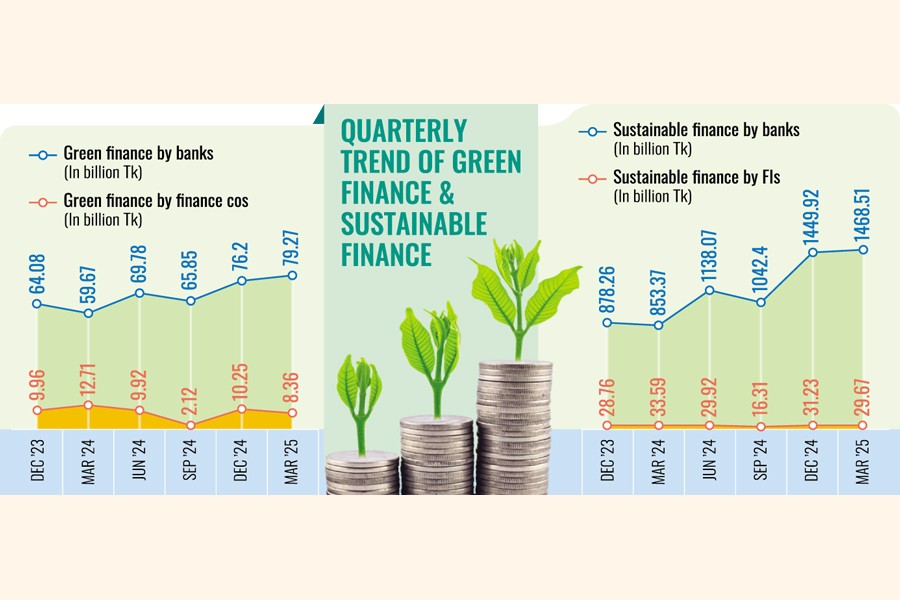
Published :
Updated :

Banks and non-bank financial institutions (NBFIs) report a strong rebound in both green and sustainable finance during January-March 2025, reflecting renewed institutional focus on climate and sustainability-focused lending.
The latest figures show year-on-year (YoY) growth across both green and sustainable finances provided by banks and NBFIs.
According to Bangladesh Bank (BB) data, green finance disbursement rose to Tk 87.63 billion in January-March 2025, up from Tk 72.40 billion in the same period of 2024 -- a 21 per cent year-on-year increase.
Green finance also showed a modest quarter-on-quarter (QoQ) rise of Tk 1.18 billion (1.36 per cent), highlighting a turnaround in lending momentum.
Sustainable finance recorded an even sharper surge. Total disbursement reached over Tk 1.49 trillion in January-March 2025, compared to Tk 886.97 billion in the same period of 2024 -- a staggering 68.9 per cent year-on-year growth. On a quarter-to-quarter basis, sustainable finance increased by Tk 17.04 billion.
Stakeholders say the year-on-year trend indicates financial institutions are scaling up their commitments to green and sustainable financing, likely in response to regulatory nudges, rising ESG compliance pressure, and growing private-sector demand for environmentally friendly credit.
While quarter-on-quarter growth remains moderate, the sharp annual surge signals a structural shift in financing priorities, bringing the country's financial sector closer to its green transition targets.
For 2025, the green finance target for banks and finance companies is set at Tk 678.21 billion, and the sustainable finance target at Tk 5.43 trillion, based on net loans and advances outstanding as of December 31, 2024.
From 2025 onwards, banks and finance companies are expected to set green finance targets at 5.0 per cent and sustainable finance targets at 40 per cent of their net loans and advances outstanding.
Shafiqul Alam, lead energy analyst for Bangladesh at the Institute for Energy Economics and Financial Analysis (IEEFA), said growing awareness among entrepreneurs and enhanced understanding by financial institutions of the need to channel finance to green and sustainable projects have led to the surge in green and sustainable finance disbursement.
The central bank's targets for green finance (5.0 per cent of loans) and sustainable finance (40 per cent of loans) have prompted financial institutions to increase lending to sustainable and green projects, he told The Financial Express.
The introduction of the Sustainable Finance Policy has given banks and finance companies an opportunity to contribute to inclusive, sustainable green growth. This includes green finance, sustainable agriculture, sustainable CMSME (small and medium-sized enterprises), socially responsible financing, and other sustainability-linked activities.
Sustainable finance refers to business conducted in ways that reduce both external carbon emissions and internal carbon footprint.
Mr Alam also noted that the number of green industries is increasing. Entrepreneurs require upfront capital for green industries, which also expands the overall share of sustainable finance.
"While financial institutions conduct eligibility checks to determine whether projects are sustainable, it would be worthwhile to perform post-implementation assessments to verify the sustainability of some projects," he added.
sajibur@gmail.com


 For all latest news, follow The Financial Express Google News channel.
For all latest news, follow The Financial Express Google News channel.